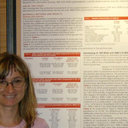1267 HSP70-2 polymorphism as a risk factor for carotid plaque rupture and cerebral ischaemia in old type 2 diabetes-atherosclerotic patients.
Кључне речи
Апстрактан
Patients with type 2 diabetes mellitus (NIDDM) are at risk for macrovascular disease complications, such as myocardial infarction (MI) or stroke from plaque rupture. Cytokines play a key role in plaque vulnerability. IFN-gamma inhibits collagen synthesis thereby affecting plaque stability. High IL-6, TNF-alpha, and dyslipidemia are risk factors for thrombosis. Abnormal increments of HSP70 in atherosclerotic plaques might lead to plaque instability and rupture caused by chronic inflammation, which up-regulates the expression of pro-inflammatory cytokines (IL-6 and TNF-alpha) in human monocytes. Studies of a polymorphic PstI site lying in the coding region at position 1267 of the HSP70-2 gene have shown that the BB genotype is associated with NIDDM. We screened 60 old NIDDM patients with carotid stenosis and 107 old healthy controls for 1267 HSP70-2 polymorphism in order to establish if an association with plaque frailty exists. Different genotypic distributions were observed between patients and healthy controls. An increased relative risk was associated with the B allele (p = 0.0107; odds ratio = 1.861). HSP70-2, IL-6, IFN-gamma, TNF-alpha gene expressions within the plaques and serum levels of triglyceride, total cholesterol and LDL cholesterol were tested from patients stratified according to their B+ (AB and BB) and B- (AA) genotypes. Plaque morphology (soft or fibrous-calcified) and the incidence of cerebral ischaemia were also assessed. B+ patients showed increased HSP70-2, IL-6, IFN-gamma, TNF-alpha and dyslipidemia as compared to B- carriers. The frequency of soft plaques increased in B+ in comparison to B- patients (67% versus 13%; odds ratio 13.0, p = 0.0006). A higher frequency of cerebral ischaemia (ictus or transient ischaemic attack (TIA)) was present in B+ than in B- genotype (53% versus 20%; odds ratio 4.57, p < 0.05) Hence, 1267 HSP70-2 polymorphism may be of use in identifying B+ NIDDM patients at risk for carotid plaque rupture and cerebral ischaemia.



